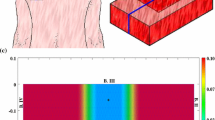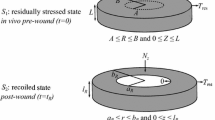Abstract
The normal process of dermal wound healing fails in some cases, due to fibro-proliferative disorders such as keloid and hypertrophic scars. These types of abnormal healing may be regarded as pathologically excessive responses to wounding in terms of fibroblastic cell profiles and their inflammatory growth-factor mediators. Biologically, these conditions are poorly understood and current medical treatments are thus unreliable.
In this paper, the authors apply an existing deterministic mathematical model for fibroplasia and wound contraction in adult mammalian dermis (Olsenet al., J. theor. Biol. 177, 113–128, 1995) to investigate key clinical problems concerning these healing disorders. A caricature model is proposed which retains the fundamental cellular and chemical components of the full model, in order to analyse the spatiotemporal dynamics of the initiation, progression, cessation and regression of fibro-contractive diseases in relation to normal healing. This model accounts for fibroblastic cell migration, proliferation and death and growth-factor diffusion, production by cells and tissue removal/decay.
Explicit results are obtained in terms of the model processes and parameters. The rate of cellular production of the chemical is shown to be critical to the development of a stable pathological state. Further, cessation and/or regression of the disease depend on appropriate spatiotemporally varying forms for this production rate, which can be understood in terms of the bistability of the normal dermal and pathological steady states—a central property of the model, which is evident from stability and bifurcation analyses.
The work predicts novel, biologically realistic and testable pathogenic and control mechanisms, the understanding of which will lead toward more effective strategies for clinical therapy of fibro-proliferative disorders.
Similar content being viewed by others
References
Asmussen, P. D. and B. Söllner. 1993.Wound Care. Principles of Wound Healing. Hamburg: Beiersdorf Medical Bibliothek.
Bell, E., B. Ivarsson and C. Merrill. 1979. Production of a tissue-like structure by contraction of collagen lattices by human fibroblasts of different proliferative potentialin vitro.Proc. Natl. Acad. Sci. USA 76, 1274–1278.
Bowen-Pope, D. F., T. W. Malpass, D. M. Foster and R. Ross. 1984. Platelet-derived growth factorin vivo: levels, activity and rate of clearance.Blood 64, 458–469.
Boykin, J. V. and J. A. Molnar. 1992. Burn scar and skin equivalents. InWound Healing: Biochemical and Clinical Aspects. I. K. Cohen, R. F. Diegelmann and W. J. Lindblad (Eds), pp. 523–540. Philadelphia: Saunders.
Clark, R. A. F. 1988. Overview and general considerations of wound repair. InThe Molecular and Cellular Biology of Wound Repair. R. A. F. Clark and P. M. Henson (Eds), pp. 3–34. New York: Plenum.
Clark, R. A. F. 1991. Growth factors and wound repair.J. Cell. Biochem. 46, 1–2.
Clark, R. A. F. 1993. Regulation of fibroplasia in cutaneous wound repair.Am. J. Med. Sci. 306, 42–48.
Dale, P. D., P. K. Maini and J. A. Sherratt. 1994. Mathematical modelling of corneal epithelial wound healing.Math. Biosci. 124, 127–147.
Ehrlich, H. P., A. Desmoulière, R. F. Diegelmann, I. K. Cohen, C. C. Compton, W. L. Garner, Y. Kapanci and G. Gabbiani. 1994. Morphological and immunochemical differences between keloid and hypertrophic scar.Am. J. Pathol. 145, 105–113.
Flint, M. H. 1990. Connective tissue biology. InDupuytren's Disease: Biology and Treatment. R. M. McFarlane, D. A. McGrouther and M. H. Flint (Eds), p. 13–24. Edinburgh: Churchill Livingstone.
Gabbiani, G. 1992. The biology of the myofibroblast.Kidney Int. 41, 530–532.
Jennings, R. W. and T. K. Hunt. 1992. Overview of postnatal wound healing. InFetal Wound Healing, N. S. Adzick and M. T. Longaker (Eds), pp. 25–52. New York: Elsevier.
Kirsner, R. S. and W. H. Eaglstein. 1993. The wound healing process.Dermatol. Clin. 11, 629–640.
Martin, P., J. Hopkinson-Woolley and J. McCluskey. 1992. Growth factors and cutaneous wound repair.Prog. Growth Fact. Res. 4, 24–44.
Mast, B. A. 1992. The skin. InWound Healing: Biochemical and Clinical Aspects. I. K. Cohen, R. F. Diegelmann and W. J. Lindblad (Eds), pp. 344–355. Philadelphia: Saunders.
McCann, B. G., A. Logan, H. Belcher, A. Warn and R. M. Warn. 1993. The presence of myofibroblasts in patients with Dupuytren's Contracture. A possible source for recurrence.J. Hand Surg. Br. 18, 656–661.
Murray, J. C. 1993. Scars and keloids.Dermatol. Clin. 11, 697–708.
Murray, J. C. and S. R. Pinnell. 1992. Keloids and excessive dermal scarring. InWound Healing: Biochemical and Clinical Aspects. I. K. Cohen, R. F. Diegelmann and W. J. Lindblad (Eds), pp. 500–509, Philadelphia: Saunders.
Murray, J. D. 1989.Mathematical Biology. New York: Springer-Verlag.
Murray, J. D., P. K. Maini and R. T. Tranquillo. 1988. Mechanochemical models for generating biological pattern and form in development.Phys. Rep.,171, 59–84.
Olsen, L., J. A. Sherratt and P. K. Maini. 1995. A mechanochemical model for adult dermal wound contraction and the permanence of the contracted tissue displacement profile.J. theor. Biol. 177, 113–128.
Raines, E. W., D. F. Bowen-Pope and R. Ross. 1990. Platelet-derived growth factor. InHandbook of Experimental Pharmacology. M. B. Sporn and A. B. Roberts (Eds), Vol. 95, Part I, pp. 173–262. Heidelberg: Springer-Verlag.
Rudolph, R., J. Vande Berg and H. P. Ehrlich. 1992. Wound contraction and scar contracture. InWound Healing: Biochemical and Clinical Aspects. I. K. Cohen, R. F. Diegelmann and W. J. Lindblad (Eds), pp. 96–114. Philadelphia: Saunders.
Rudolph, R. and J. Vande Berg. 1991. The myofibroblast in Dupuytren's contracture.Hand Clin. 7, 683–692.
Schürch, W., O. Skalli and G. Gabbiani. 1990. Cellular biology. InDupuytren's Disease: Biology and Treatment. R. M. McFarlane, D. A. McGrouther and M. H. Flint (Eds), pp. 31–47. Edinburgh: Churchill Livingstone.
Sherratt, J. A., E. H. Sage and J. D. Murray. 1993. Chemical control of eukaryotic cell movement: a new model.J. theor. Biol. 162, 23–40.
Skalli, O. and G. Gabbiani. 1988. The biology of the myofibroblast. Relationship to wound contraction and fibrocontractive diseases. InThe Molecular and Cellular Biology of Wound Repair. R. A. F. Clark and P. M. Henson (Eds), pp. 373–402. New York: Plenum.
Skalli, O., W. Schürch, T. Seemayer, R. Lagacé, D. Montandon, B. Pittet and G. Gabbiani. 1989. Myofibroblasts from diverse pathologic settings are heterogeneous in their content of actin isoforms and intermediate filament proteins.Lab. Invest. 60, 275–285.
Sprugel, K. H., J. M. McPherson, A. W. Clowes and R. Ross. 1987. Effects of growth factorsin vivo.Am. J. Pathol. 129, 601–613.
Tranquillo, R. T. and J. D. Murray. 1992. Continuum model of fibroblast-driven wound contraction: inflammation-mediation.J. theor. Biol. 158, 135–172.
Traqui, P., D. E. Woodward, G. C. Cruywagen, J. Cook and J. D. Murray. 1996. A mechanical model for fibroblast-driven wound healing.J. Biol. Systems, in press.
Vande Berg, J. S., R. Rudolph, W. L. Poolman and D. R. Disharoon. 1988. Comparative growth dynamics and actin concentration between cultured human myofibroblasts from granulating wounds and dermal fibroblasts from normal skin.Lab. Invest. 61, 532–538.
Author information
Authors and Affiliations
Rights and permissions
About this article
Cite this article
Olsen, L., Sherratt, J.A. & Maini, P.K. A mathematical model for fibro-proliferative wound healing disorders. Bltn Mathcal Biology 58, 787–808 (1996). https://doi.org/10.1007/BF02459482
Received:
Accepted:
Issue Date:
DOI: https://doi.org/10.1007/BF02459482




